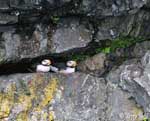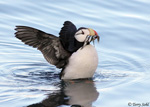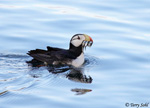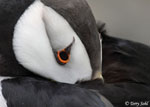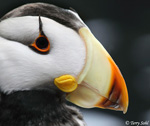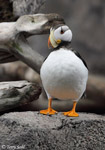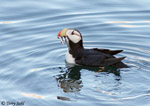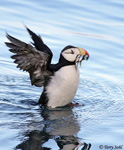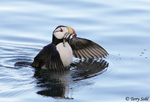| Length: 15 inches | Wingspan: 22-24 inches | Seasonality: Non-resident in South Dakota |
| ID Keys: Large bill, yellow bill base (breeding), large fleshy "horn" above eyes, Pacific Coast range | ||
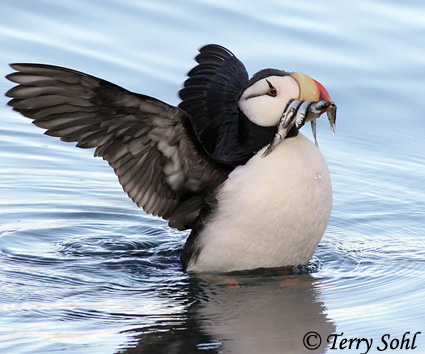 Horned
Puffins are very similar to the Atlantic Puffin of the Atlantic Coast, but are
found along the Pacific Coast, primarily around Alaska and the west coast of
Canada. They are also larger than their close relative in the Atlantic,
and have different colors on their bills. Horned Puffins nest on rocky
islands on the coastline of Alaska and the Aleutians, but in winter may range
widely through the North Pacific. The Tufted Puffin also shares much of
the same habitat as the Horned Puffin, but with a good view, the two species are
generally easy to differentiate. The photo on the right shows an
adult Horned Puffin with a beakful of fish, a common sight when Puffins are
raising their (single) chick and foraging for food to bring back to the nest.
Horned
Puffins are very similar to the Atlantic Puffin of the Atlantic Coast, but are
found along the Pacific Coast, primarily around Alaska and the west coast of
Canada. They are also larger than their close relative in the Atlantic,
and have different colors on their bills. Horned Puffins nest on rocky
islands on the coastline of Alaska and the Aleutians, but in winter may range
widely through the North Pacific. The Tufted Puffin also shares much of
the same habitat as the Horned Puffin, but with a good view, the two species are
generally easy to differentiate. The photo on the right shows an
adult Horned Puffin with a beakful of fish, a common sight when Puffins are
raising their (single) chick and foraging for food to bring back to the nest.
Habitat: Breeds on rocky islands, using crevices on rocky cliffs or burrows for nesting. In summer during the breeding season, they are primarily found near the coastline and their breeding grounds, but in winter, they may be found far out in the open Pacific Ocean.
Diet: Fish makes up a majority of the diet, with capelin and sand lance particularly preferred. While the young are fed a diet of almost entirely fish, the adults will also feed on squid, crustaceans, and marine worms.
Behavior: During the summer breeding months, they are typically found nesting in colonies, often in conjunction with other Alcids. Food is acquired by swimming underwater and capturing fish and other prey with their beaks.
Nesting: Horned Puffins typically nest in burrows that are between 1 and 3 feet deep, although they will also often use crevices in cliff faces, or in protected areas among rocky boulders. Nesting colonies are almost exlusively found on offshore, rocky islands.
Song: Horned Puffins adults at sea are generally quiet. Birds on breeding colonies often make low groans.
Migration: After breeding in a fairly narrow range in Alaska, birds disperse over a fairly large area of the North Atlantic, often being found very far offshore in the winter months.
Interactive eBird Map:
Click here to access an interactive eBird map of Horned Puffin sightingsSimilar Species: Tufted Puffin, Atlantic Puffin
Conservation Status: The species is still widespread and relatively common in Alaska. Local declines occur when introduced predators such as rats or foxes are introduced on their offshore breeding colonies, but populations are generally stable.
Further Information: 1) Birdweb.org - Horned Puffin
3) Audubon Guide- Horned Puffin
Photo Information: August 8th, 2010 - Fox Island, Ressurection Bay, Alaska - Terry Sohl
Additional Photos: Click on the image chips or text links below for additional, higher-resolution Horned Puffin photos.
| Click on the map below for a higher resolution view |
 |
| South Dakota Status: Non-resident in South Dakota |
Additional Horned Puffin Photos
Click for a higher-resolution version of these photos
